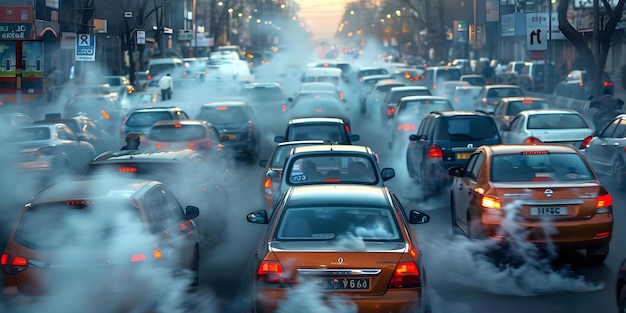About 32,500 people died from air pollution-related diseases in Ghana in 2023, data from the State of Global Air 2025 report has revealed.
The Director of Public Health at the Accra Metropolitan Assembly (AMA), Florence Kuukyi, recently pegged the figure at 28,000, but the data from the report suggests that number was significantly understated.
The new figure is a nearly two percent rise from the previous year, which saw about 31,900 deaths in the country attributed to air pollution.
While the new numbers pale in comparison with those from China, which recorded 2,051,000 deaths in 2023 and India, whose air pollution-attributable deaths rose to 2,006,000 that year, the ratio of the deaths to the population in Ghana remains disproportionately high.
Household air pollution accounted for 4,541 deaths amongst children under 10 years old, while 12,790 deaths were recorded amongst persons aged between 50 and 85.
Spike in deaths
Since the turn of the century, yearly air pollution-related deaths have spiked by 37.7 percent in Ghana, rising by 8,900, while the rate of increase since 2010 is about 26 percent.Travel guides Ghana
From 2014 to 2019, Ghana recorded a steady rise in the number of deaths, but consecutive drops from 38,800 to 30,600 in 2020 and 30,300 in 2021 showed that gains had been made in creating awareness on the issue.
The trend, however, reversed in 2022 with a significant rise to 31,900 deaths, an increase of about 5 percent (1,600 deaths).
Protection and policy
A recent study noted that air pollution is now the leading cause of death in the country, with about 30,000 Ghanaians dying every year from related illnesses.
This number exceeds the country’s casualties from HIV/AIDS, malaria, and road traffic accidents.
In a bid to address this, the Environmental Protection (Air Quality Management) Regulations, 2025 (L.I. 2507) was passed in June, allowing the Environmental Protection Agency (EPA) to create and enforce limits on emissions from motor vehicles, industrial and commercial facilities, domestic, agricultural, and construction sources, and waste disposal sites.
The L.I. also mandates the implementation of a national air quality management framework, an information management system, and air quality management plans by District Assemblies.
State of Global Air
The State of Global Air 2025 report, produced by the Health Effects Institute (HEI) in collaboration with the Institute for Health Metrics and Evaluation (IHME) and the NCD Alliance, also identified air pollution as the second-leading cause of early death globally.
7.9 million deaths in 2023 were caused by air pollution, a rate of 1 in every 8 deaths across the world, with only high blood pressure leading to more early deaths globally.
4.9 million of these deaths were attributed to exposure to fine particulate matter (PM2.5), which was also identified as the fourth leading risk factor for deaths across the world.
Household air pollution, mostly from cooking with solid fuels, contributed to 2.8 million deaths, while 470,000 lives lost from ozone were mostly linked to Chronic Obstructive Pulmonary Disease (COPD), a common lung disease that restricts airflow and causes breathing problems.
90 percent of air pollution deaths were recorded in low and middle-income countries like Ghana, where a large percentage of the population still use solid fuels like charcoal and wood to cook.
While India and China account for 52 percent of global pollution deaths, countries in Eastern, Central, Southern, and West Africa, including Ghana, record 137 deaths per 100,000 people from air pollution.























































![[FREE FREE MONEY] Predict and Win a Guaranteed GH¢200 From Us EVERY WEEK](https://wordpress.ghanatalksradio.com/wp-content/uploads/2022/02/Predict-and-Win-Final-09-03-2021-218x150.jpg)
![[Predict & Win – 8th/Oct.] WIN A Guaranteed ¢200 From Us This Week](https://wordpress.ghanatalksradio.com/wp-content/uploads/2021/10/maxresdefault-16-218x150.jpg)
![[Predict & Win – 2nd] WIN A Guaranteed ¢200 From Us This Week](https://wordpress.ghanatalksradio.com/wp-content/uploads/2021/09/maxresdefault-50-218x150.jpg)
![[Predict & Win – 25th] WIN A Guaranteed ¢200 From Us This Week](https://wordpress.ghanatalksradio.com/wp-content/uploads/2021/09/maxresdefault-36-218x150.jpg)
![[Predict & Win – 18th] WIN A Guaranteed ¢200 From Us This Week](https://wordpress.ghanatalksradio.com/wp-content/uploads/2021/09/maxresdefault-23-218x150.jpg)












![[National cathedral] See full list of churches that have contributed since 2018](https://wordpress.ghanatalksradio.com/wp-content/uploads/2020/09/Ghana-National-Cathedral-GhanaTalksRadio-100x70.jpg)



